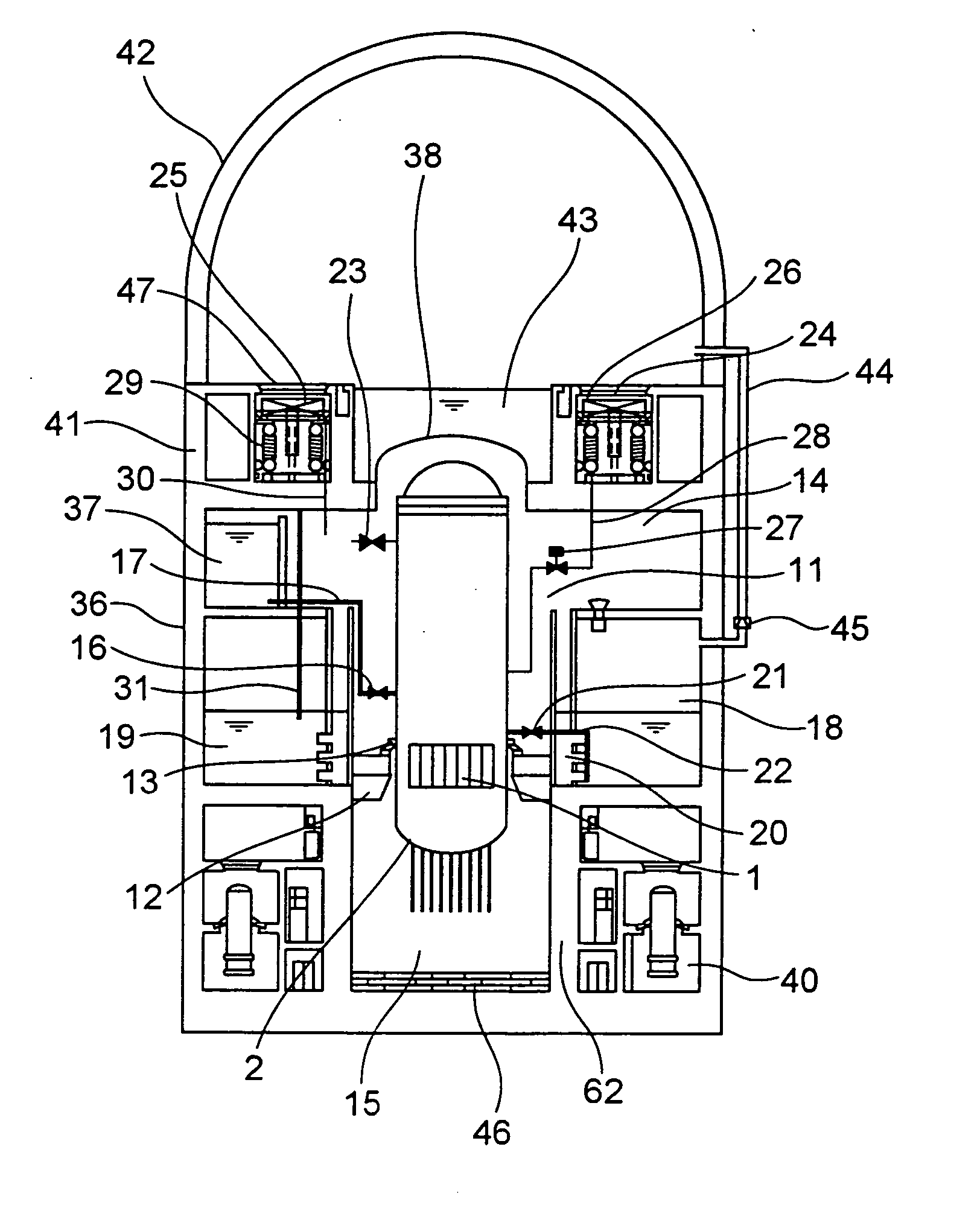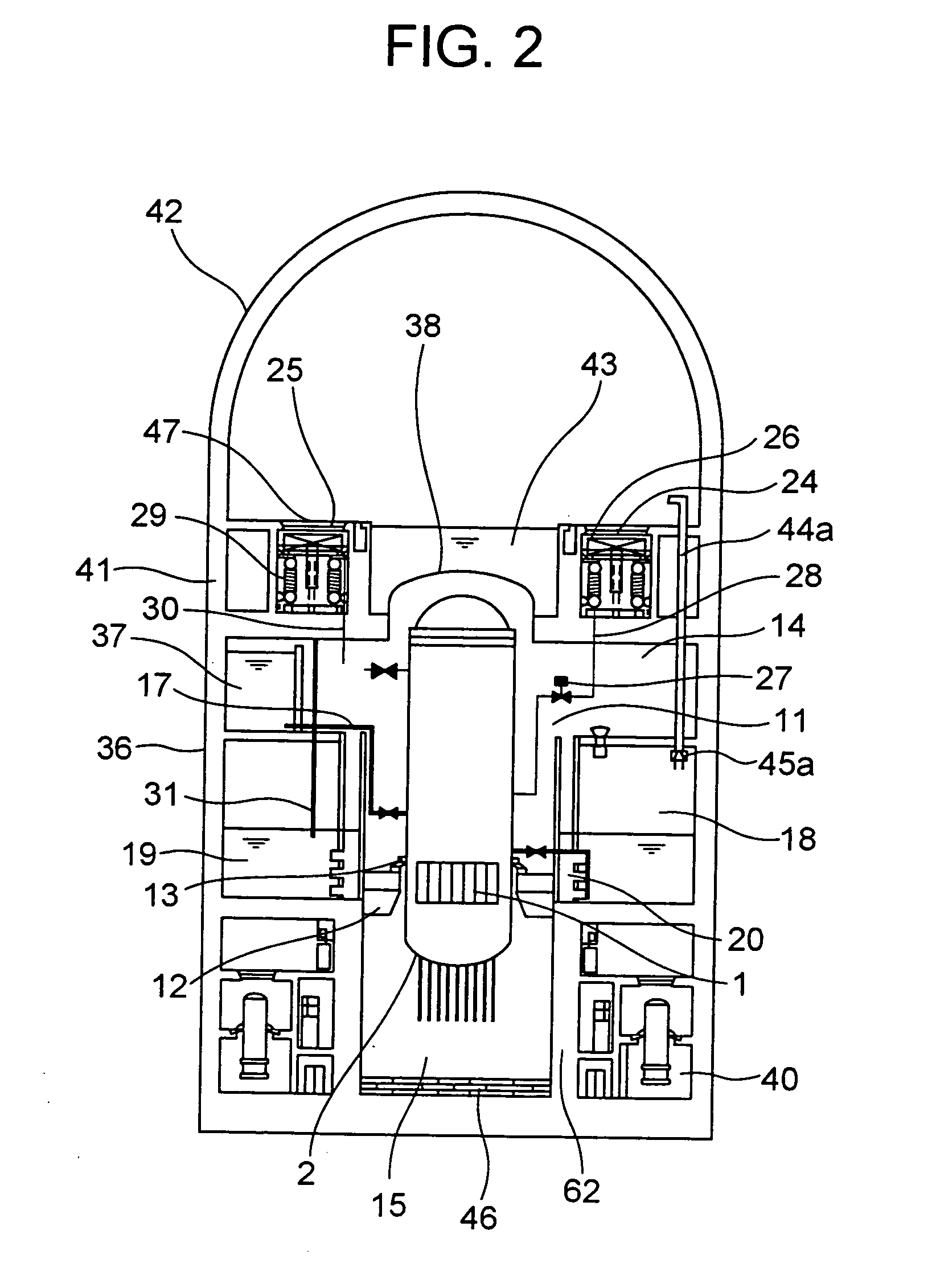Reactor containment vessel and boiling water reactor power plant
a technology for nuclear reactors and containment vessels, which is applied in nuclear engineering problems, nuclear elements, greenhouse gas reduction, etc., can solve the problems of not being able to positively function, the reactor building surrounding the primary reactor containment vessel is not pressure resistant and cannot be equipped with an active safety system by design, and the soundness of the reactor containment vessel of conventional active safety bwrs can be threatened
- Summary
- Abstract
- Description
- Claims
- Application Information
AI Technical Summary
Problems solved by technology
Method used
Image
Examples
first embodiment
[0026] a reactor containment vessel (to be referred to simply as containment vessel hereinafter) according to the present invention will be described by referring to FIG. 1. As shown in FIG. 1, a reactor pressure vessel (RPV) 2 that contains a core 1 is arranged in the inside of a dry well 11 and rigidly secured in position by means of a reactor pressure vessel support 12 by way of areactor pressure vessel skirt 13. The space above the reactor pressure vessel support 12 in the dry well 11 is referred to as upper dry well 14, whereas the space below the reactor pressure vessel support 12 in the dry well 11 is referred to as lower dry well 15.
[0027] A core catcher 46 made of thermally resistant material is arranged on the floor of the lower dry well 15. The floor surface of the lower dry well 15 is highly reinforced so as to make it particularly resistant against leakage of and corrosion by radioactive substances. The part of the wall surface of the lower dry well 15 that supports the...
second embodiment
[0059] Now, the containment vessel according to the present invention will be described by referring to FIG. 2. In this embodiment, the gas-phase vent pipe 44a is not arranged outside the containment vessel 41, but it is arranged through the dry well 11 so as to connect the wet well 18 and the upper secondary containment vessel 42. The isolation and connection switching system 45a is arranged in the gas-phase part of the wet well 18. With this arrangement, the gas-phase vent pipe 44a does not extend to the outside of the containment vessel 41, so that it is possible to avoid radioactive substances from leaking into the environment through the gas-phase vent pipe 44a even if an accident occurs.
third embodiment
[0060] Now, the containment vessel according to the present invention will be described by referring to FIG. 3. In this embodiment, the upper secondary containment vessel 42 and the primary containment vessel 36 are integrally formed as a single structure of the containment vessel 41. Additionally, the gas-phase vent pipe 44b is embedded in the wall of the containment vessel 41.
[0061] With this arrangement of the embodiment, the containment vessel 41 is realized as an integrated single structure to provide an advantage of an enhanced strength. As the gas-phase vent pipe 44b is embedded in the wall, the overall structure can be designed very compact. The maintenance of the isolation and connection switching system 45b can be conducted easily because it is located in the gas-phase part. Alternatively, the isolation and connection switching system 45b may be placed in an opening space that is formed in the wall.
PUM
 Login to View More
Login to View More Abstract
Description
Claims
Application Information
 Login to View More
Login to View More - R&D
- Intellectual Property
- Life Sciences
- Materials
- Tech Scout
- Unparalleled Data Quality
- Higher Quality Content
- 60% Fewer Hallucinations
Browse by: Latest US Patents, China's latest patents, Technical Efficacy Thesaurus, Application Domain, Technology Topic, Popular Technical Reports.
© 2025 PatSnap. All rights reserved.Legal|Privacy policy|Modern Slavery Act Transparency Statement|Sitemap|About US| Contact US: help@patsnap.com



